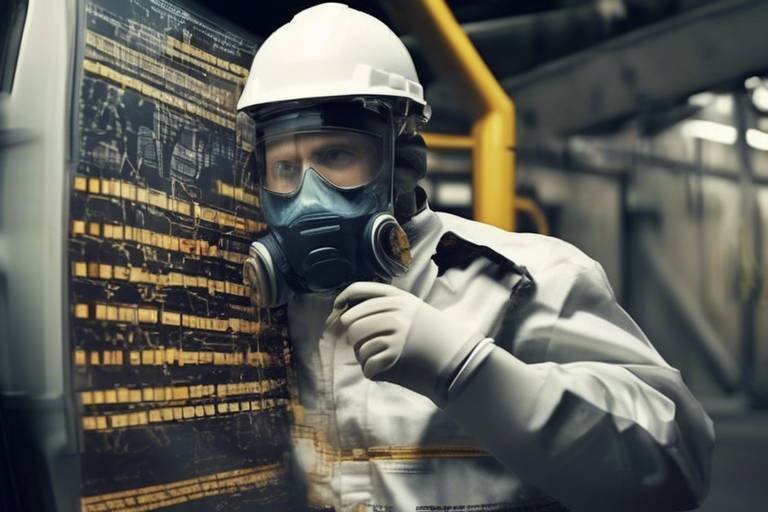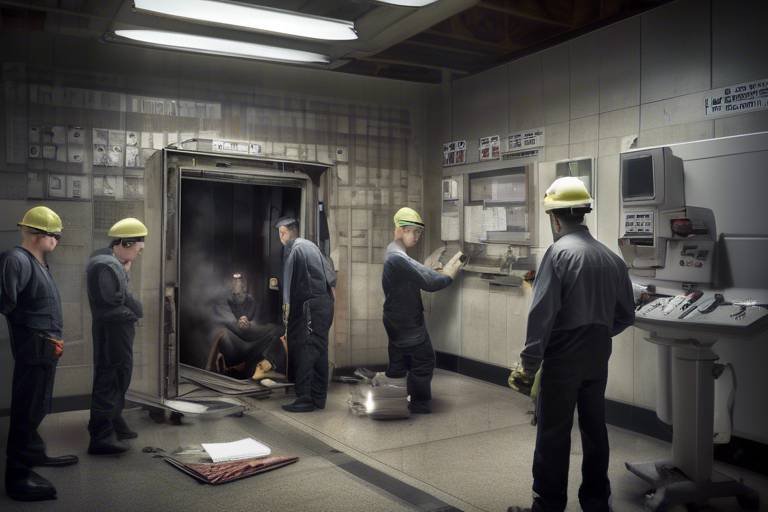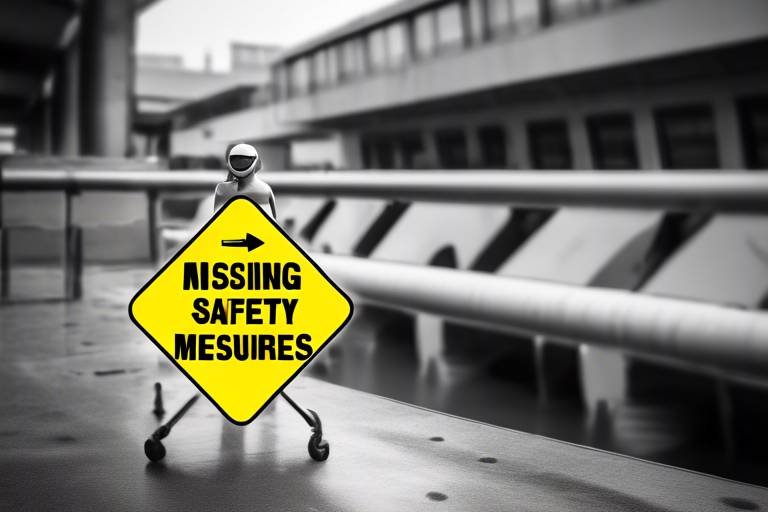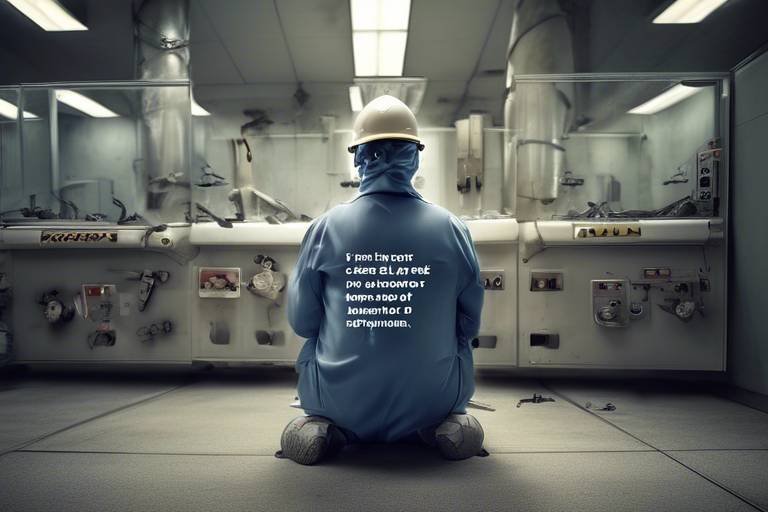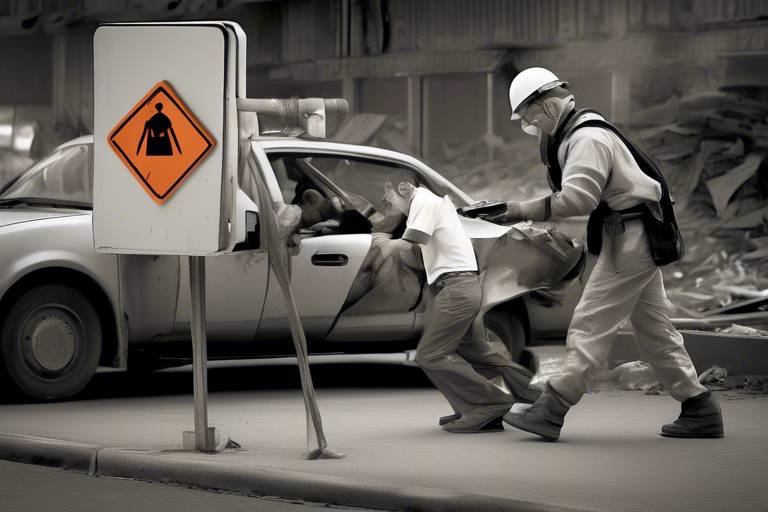The Role of Human Behavior in Determining Safety
In today's fast-paced world, the way we behave has a profound impact on safety across various environments. Whether it's in the workplace, on the road, or in our homes, human behavior can either enhance safety or create hazardous situations. It's fascinating to think about how our actions, decisions, and even our thought processes can dictate safety outcomes. Have you ever considered how a simple choice—like wearing a seatbelt or following safety protocols—can make a life-or-death difference? This article dives deep into the intricate relationship between human behavior and safety, exploring the psychological factors at play, the decision-making processes involved, and the cultural influences that shape our safety practices.
Understanding the psychological factors that influence human behavior is crucial for improving safety protocols and practices in any environment, from workplaces to public spaces. Our minds are powerful, and they can either help us make informed, safe choices or lead us down a path of recklessness. For instance, when faced with a dangerous situation, our instincts kick in, but are those instincts always reliable? Oftentimes, emotions like fear or overconfidence can cloud our judgment, leading us to underestimate risks. By studying these psychological underpinnings, organizations can develop strategies that not only raise awareness but also promote safer behaviors among individuals.
Human decision-making plays a pivotal role in safety outcomes. Imagine you're driving and suddenly see a red light ahead. Your reaction—whether to slam the brakes or to coast through—can be a matter of seconds that determines safety. This section discusses how cognitive biases and heuristics can affect choices in critical situations. Cognitive biases, like the optimism bias, can lead us to believe that accidents won't happen to us, while heuristics can simplify complex decisions but may also overlook essential safety considerations. Recognizing these influences is key to fostering a culture of safety.
Risk perception varies among individuals and can significantly influence safety-related decisions. Factors such as personal experiences, cultural background, and even media portrayals shape how we assess risks. For example, someone who has experienced a car accident may be more cautious while driving, while another person might view the same situation as low-risk due to a lack of personal experience. This subsection delves into the factors that shape how people assess risks, highlighting the importance of understanding these perceptions to promote safer choices.
Social dynamics and peer pressure can impact individual perceptions of risk and safety behaviors. Have you ever found yourself doing something risky because your friends encouraged it? This is a common scenario that illustrates how our social circles can influence our decisions. Understanding these influences is essential for fostering safer environments. By creating a culture where safety is prioritized and peer support is encouraged, organizations can significantly reduce risky behaviors.
Cognitive biases can lead to misjudgments in assessing safety risks. For instance, the availability heuristic might cause individuals to overestimate the likelihood of dramatic events, like plane crashes, while underestimating more common risks, such as car accidents. This section discusses common biases and their implications for safety practices, emphasizing the need for training and awareness programs that address these cognitive pitfalls.
Implementing behavioral safety strategies can enhance safety culture in organizations. These strategies focus on encouraging safe behaviors through positive reinforcement and continuous feedback. For example, organizations can implement reward systems for employees who consistently follow safety protocols. This subsection explores effective methods for promoting safe behaviors among employees, illustrating how a proactive approach can lead to a significant reduction in accidents and injuries.
Cultural attitudes towards safety can shape behavior significantly. In some organizations, safety may be viewed as a priority, while in others, it might take a backseat to productivity. This section examines how organizational and societal culture influences safety practices, highlighting the importance of aligning safety goals with company values.
Effective safety training programs are crucial for instilling a culture of safety. These programs should not only cover the "how-tos" of safety procedures but also engage employees in understanding the "why" behind them. This subsection discusses best practices in developing and implementing training initiatives, emphasizing the need for ongoing education and reinforcement to ensure that safety becomes a part of everyday behavior.
Leadership plays a vital role in establishing a safety culture. Leaders set the tone for safety practices and behaviors within their organizations. By modeling safe behaviors and prioritizing safety in decision-making, leaders can influence safety attitudes among employees. This section explores how leaders can influence safety behaviors and attitudes within their organizations, demonstrating that a commitment to safety starts at the top.
- What is the importance of understanding human behavior in safety? Understanding human behavior is crucial for developing effective safety protocols and practices that resonate with individuals.
- How do cognitive biases affect safety decisions? Cognitive biases can lead to misjudgments in risk assessment, impacting safety outcomes.
- What role does culture play in safety practices? Cultural attitudes towards safety can significantly influence behaviors and practices within an organization.
- How can organizations promote a safety culture? Organizations can promote a safety culture through effective training, leadership commitment, and positive reinforcement of safe behaviors.

The Psychology of Safety
Understanding the psychological factors that influence human behavior is crucial for improving safety protocols and practices in any environment, from workplaces to public spaces. At the core of safety psychology lies the recognition that our thoughts, emotions, and perceptions can significantly impact how we respond to potential hazards. For instance, when individuals feel overconfident in their abilities, they may underestimate risks, leading to unsafe behaviors. Conversely, a heightened sense of fear can cause irrational decision-making, which may also compromise safety.
One key aspect of safety psychology is risk perception. This refers to how individuals evaluate the likelihood and severity of potential dangers. It’s fascinating to see that risk perception can vary dramatically from person to person. Factors such as personal experiences, cultural background, and even media influence can shape how we assess risks. For example, someone who has experienced a workplace accident may perceive risks more acutely than someone who has never encountered such situations. This variance can lead to discrepancies in safety practices across different groups.
Moreover, the social environment plays a pivotal role in shaping safety behaviors. Humans are inherently social creatures, and our behaviors are often influenced by those around us. Peer pressure can lead individuals to take risks they might otherwise avoid. In a workplace setting, if employees observe their colleagues engaging in unsafe practices without repercussions, they may feel compelled to follow suit, thinking, "If they can do it, so can I." This phenomenon highlights the importance of fostering a culture of safety where safe behaviors are not only encouraged but celebrated.
To further illustrate the psychological elements at play in safety, consider the following factors:
- Emotional State: Emotions can cloud judgment. When people are stressed or anxious, they may overlook safety protocols.
- Experience Level: Novice workers may have a different perception of risk compared to seasoned employees.
- Training and Awareness: Proper training can enhance risk perception and promote safer behaviors.
Understanding these psychological dynamics is not just academic; it has real-world implications. Organizations can leverage this knowledge to develop more effective safety training programs that address these psychological barriers. By creating a supportive environment that recognizes the human element of safety, organizations can foster a culture where safety is prioritized and ingrained into daily practices.
In summary, the psychology of safety is a multifaceted area that intertwines individual perceptions, emotions, and social influences. By delving into these psychological aspects, we can better understand how to enhance safety practices and ultimately save lives.

Decision-Making Processes
When it comes to safety, the of individuals are paramount. Imagine you’re at a crowded event, and suddenly a fire alarm goes off. What do you do? Do you panic, or do you calmly assess the situation? The choices we make in such critical moments can have profound implications on our safety and that of others around us. Understanding how we make these decisions is crucial for enhancing safety protocols across various environments.
One of the main factors that influence our decision-making is cognitive biases. These are systematic patterns of deviation from norm or rationality in judgment. They can affect our ability to make safe choices, often leading us to underestimate risks or overestimate our ability to handle dangerous situations. For instance, the optimism bias makes us believe that we are less likely to experience negative events compared to others. This can lead to risky behaviors, such as not wearing a seatbelt or ignoring safety guidelines.
Another aspect to consider is heuristics, which are mental shortcuts that help us make quick decisions. While heuristics can be useful, they can also lead to errors in judgment, especially in high-pressure scenarios. For example, if someone has had a good experience with a particular safety practice in the past, they might assume it will always work, disregarding current circumstances that may have changed. This reliance on past experiences can be dangerous and highlights the need for continuous education and awareness regarding safety practices.
Risk perception is an individual’s assessment of how dangerous a situation is, and it varies widely among people. Factors such as personal experiences, cultural background, and even media influence can shape how we perceive risks. For instance, someone who has never been in a car accident may underestimate the dangers of distracted driving, while another individual who has witnessed a serious accident may be overly cautious. This variability in risk perception is crucial for safety professionals to understand when designing safety protocols.
Social dynamics play a significant role in shaping our perceptions of risk and safety behaviors. Have you ever noticed how people tend to follow the crowd? This phenomenon, known as social proof, can lead to either positive or negative safety outcomes. For example, if most people in a group are ignoring a safety guideline, an individual may feel pressured to do the same, even if they know it’s not the right choice. Conversely, if a culture of safety is prevalent in a group, individuals are more likely to adhere to safe practices.
There are several common cognitive biases that can lead to misjudgments in assessing safety risks. Here are a few:
- Confirmation Bias: The tendency to search for, interpret, and remember information in a way that confirms one’s pre-existing beliefs.
- Anchoring Bias: The reliance on the first piece of information encountered when making decisions.
- Availability Heuristic: Overestimating the importance of information readily available in memory, often influenced by recent events.
Recognizing these biases is the first step toward mitigating their effects on our safety decisions. By fostering an environment where individuals are encouraged to question their assumptions and consider alternative perspectives, organizations can improve their overall safety culture.
Implementing effective behavioral safety strategies can significantly enhance safety outcomes in various settings. Organizations can promote safe behaviors through training programs that emphasize the importance of decision-making processes. For instance, role-playing scenarios can help individuals practice responding to emergencies in a controlled environment, allowing them to develop better decision-making skills under pressure. Additionally, encouraging open communication about safety concerns can empower employees to speak up and take action when they perceive risks.
In conclusion, understanding the intricacies of human decision-making processes is essential for fostering a culture of safety. By acknowledging the psychological factors at play, organizations can better equip individuals to make informed choices that prioritize safety. The journey to safety begins with informed decision-making, and it is a collective effort that requires awareness, education, and a commitment to continuous improvement.
Q: How can organizations improve decision-making processes related to safety?
A: Organizations can enhance decision-making by providing training that focuses on recognizing cognitive biases, encouraging open discussions about safety, and implementing real-life scenario practices.
Q: What role does culture play in safety decision-making?
A: Culture greatly influences how individuals perceive risks and make decisions. A strong safety culture encourages adherence to safety practices and empowers individuals to prioritize safety in their decision-making.
Q: How can individuals overcome cognitive biases in safety-related decisions?
A: Individuals can work to overcome cognitive biases by seeking diverse perspectives, questioning their assumptions, and staying informed about safety practices and guidelines.

Risk Perception
Risk perception is a fascinating and complex phenomenon that varies significantly among individuals. It refers to the subjective judgment people make about the characteristics and severity of a risk. Imagine standing at the edge of a cliff; while one person might feel exhilarated by the view, another could be paralyzed by fear. This variance in perception can dramatically influence safety-related decisions, making it crucial to understand the underlying factors that shape these assessments.
Several elements contribute to how we perceive risk, including personal experiences, cultural background, and even social influences. For instance, someone who has experienced a workplace accident may view similar situations as highly dangerous, while another individual, who has never faced such an event, may underestimate the risks involved. This disparity can lead to significant consequences in terms of safety practices. To illustrate this point, consider the following factors that shape risk perception:
- Personal Experience: Past experiences can create a filter through which all future risks are assessed. A person who has been in a car accident might be more cautious when driving.
- Media Influence: The portrayal of risks in the media can amplify or diminish perceived threats. Sensational news stories can make people more fearful, while lack of coverage on certain issues can lead to underestimating their dangers.
- Social Dynamics: The opinions and behaviors of peers can heavily influence how we assess risk. If a group of friends engages in risky behavior without consequence, an individual may feel encouraged to do the same.
Moreover, cognitive biases play a crucial role in risk perception. For example, the availability heuristic leads people to judge the frequency of events based on how easily examples come to mind. If someone frequently hears about airplane accidents, they might perceive flying as more dangerous than it statistically is. This cognitive shortcut can lead to irrational fears and poor decision-making.
Understanding risk perception is not just an academic exercise; it has real-world implications. Organizations can benefit from recognizing how their employees perceive risks. By fostering an environment where open discussions about risks are encouraged, companies can address misconceptions and promote safer behaviors. Training sessions that include real-life scenarios can help bridge the gap between perception and reality, ultimately leading to a more informed workforce.
In summary, risk perception is a multifaceted aspect of human behavior that significantly impacts safety decisions. By acknowledging the various factors that influence how risks are assessed, we can work towards creating safer environments that account for these perceptions. It's about transforming fear into informed action, ensuring that everyone feels empowered to make safe choices.
- What is risk perception? Risk perception refers to the subjective judgment individuals make about the characteristics and severity of a risk.
- How does personal experience affect risk perception? Personal experiences can create a filter that influences how future risks are assessed, often leading to heightened caution or underestimation of danger.
- What role does media play in shaping risk perception? Media portrayals can amplify fears or diminish perceived threats, affecting how individuals assess various risks.
- How can organizations improve safety based on risk perception? By fostering open discussions about risks and incorporating real-life scenarios into training, organizations can better align perceptions with actual risks, promoting safer behaviors.

Social Influences
When it comes to safety, the impact of cannot be overstated. Our behaviors are often shaped by the people around us, whether we realize it or not. Think about it: how many times have you made a decision based on what your friends or colleagues thought? In many cases, we tend to conform to the norms and expectations of our social circles, which can either bolster or undermine safety practices. This phenomenon is especially prevalent in high-risk environments where peer pressure can lead individuals to take unnecessary risks.
Consider a workplace scenario where employees are expected to wear safety gear. If the majority of the team chooses to forgo their helmets or protective eyewear, others may feel compelled to follow suit, believing that fitting in is more important than adhering to safety protocols. This is a classic example of how social dynamics can create a culture that either promotes or diminishes safety. The desire to belong often outweighs the instinct for self-preservation, leading to a dangerous mindset.
Moreover, social influences extend beyond immediate peer groups. Media portrayals, community standards, and even cultural narratives play a significant role in shaping our perceptions of risk and safety. For instance, if a popular television show depicts reckless behavior without consequences, viewers may subconsciously adopt similar attitudes in their own lives. This is why it’s crucial for organizations to not only enforce safety regulations but also to actively promote a culture of safety through positive social reinforcement.
To better understand the role of social influences on safety, let’s explore some key factors:
- Peer Pressure: The tendency to conform to the behaviors of those around us can lead to risky choices.
- Group Norms: Established norms within a group can dictate acceptable safety practices, either positively or negatively.
- Leadership Influence: Leaders set the tone for safety culture. Their attitudes and behaviors can inspire or discourage safe practices among team members.
Ultimately, recognizing the power of social influences is essential for fostering a safer environment. By understanding how our interactions with others shape our behaviors, organizations can develop strategies to promote positive safety practices. Whether it’s through team-building exercises, open discussions about safety, or leadership training, creating an atmosphere where safety is prioritized can significantly reduce risk. After all, when individuals feel supported by their peers and leaders, they are more likely to make decisions that protect not only themselves but also their colleagues.
Q: How can organizations combat negative social influences on safety?
A: Organizations can combat negative social influences by fostering a culture of open communication, encouraging employees to speak up about unsafe practices, and providing training that emphasizes the importance of safety over conformity.
Q: What role does leadership play in shaping safety culture?
A: Leadership is crucial in shaping safety culture as leaders set the example for their teams. When leaders prioritize safety and model safe behaviors, employees are more likely to follow suit.
Q: Can social media impact safety behaviors?
A: Yes, social media can significantly impact safety behaviors. Positive safety campaigns can spread awareness, while negative portrayals of reckless behavior can influence individuals to take unnecessary risks.

Cognitive Biases
Cognitive biases are systematic patterns of deviation from norm or rationality in judgment. In the context of safety, these biases can lead individuals to make poor decisions that compromise their well-being and that of others. For instance, the optimism bias can cause people to underestimate the likelihood of experiencing negative outcomes, such as accidents or injuries. This can result in a lax attitude towards safety protocols, as individuals believe that "it won't happen to me." Imagine driving without a seatbelt because you think you're a careful driver; that's optimism bias at work!
Another common bias is the availability heuristic, where people assess the probability of an event based on how easily an example comes to mind. If someone has recently heard about a workplace accident, they may overestimate the risk of that happening in their own environment, leading to unnecessary fear and anxiety. On the flip side, if they haven’t encountered any issues, they might dismiss safety measures altogether, thinking they are unnecessary. This inconsistency can create a dangerous gap in safety practices.
Furthermore, the confirmation bias plays a crucial role in shaping safety behaviors. This bias leads individuals to favor information that confirms their pre-existing beliefs while disregarding evidence that contradicts them. For example, if an employee believes that their workplace is safe, they might ignore reports of unsafe conditions or dismiss safety training as irrelevant. This selective perception can hinder the implementation of effective safety measures and create an environment where risks are overlooked.
To illustrate these biases more clearly, consider the following table that highlights some common cognitive biases and their implications for safety:
| Cognitive Bias | Description | Implication for Safety |
|---|---|---|
| Optimism Bias | Underestimating the risk of negative events. | Neglecting safety protocols due to a false sense of security. |
| Availability Heuristic | Evaluating risk based on recent experiences or examples. | Overreacting or underreacting to safety concerns. |
| Confirmation Bias | Favoring information that supports existing beliefs. | Ignoring critical safety information that challenges personal views. |
Addressing these cognitive biases is essential for fostering a culture of safety. Organizations can implement training programs that educate employees about these biases, helping them recognize and mitigate their effects. By fostering awareness, individuals can make more informed decisions that prioritize safety over complacency. It’s like wearing glasses to correct vision; once you see clearly, you can navigate the environment more safely!

Behavioral Safety Strategies
When it comes to enhancing safety culture in organizations, play a pivotal role. These strategies are not just about following rules; they focus on understanding and influencing the behaviors of individuals to create a safer environment. Think of it as planting seeds of safety that can grow into a culture where everyone feels responsible for their own and others' well-being.
One effective approach is to implement positive reinforcement. This means recognizing and rewarding safe behaviors rather than just punishing unsafe ones. For instance, when employees are acknowledged for following safety protocols, it not only boosts their morale but also encourages others to adopt similar behaviors. Imagine a workplace where safety is celebrated like a team victory—this can significantly shift the culture towards prioritizing safety.
Another key strategy involves engaging employees in safety discussions. By creating an open forum where team members can voice their concerns and suggestions, organizations can foster a sense of ownership over safety practices. This engagement can take the form of regular safety meetings or suggestion boxes where employees can anonymously share their thoughts. When people feel heard, they’re more likely to take safety seriously.
Moreover, conducting regular safety audits is essential. These audits help identify potential hazards and areas for improvement. They should not be a one-time event but rather a continuous process. Think of it as a health check-up for your organization’s safety practices. Regular assessments allow for adjustments to be made proactively, ensuring that safety measures are always up to date.
Training is another cornerstone of behavioral safety strategies. However, it’s important to go beyond traditional training methods. Incorporating interactive elements such as role-playing scenarios can make safety training more engaging and memorable. For example, simulating emergency situations can prepare employees to respond effectively when real crises occur. This hands-on approach not only teaches them what to do but also builds their confidence in handling unexpected situations.
Furthermore, it’s crucial to measure the effectiveness of these strategies. Organizations should track safety performance metrics, such as incident rates and employee feedback, to assess whether behavioral safety initiatives are working. By analyzing this data, leaders can make informed decisions about which strategies to continue, modify, or replace. It’s like having a compass that guides you on your journey toward a safer workplace.
In conclusion, implementing behavioral safety strategies is about creating a proactive safety culture where everyone is engaged and accountable. When employees feel empowered to contribute to safety, the entire organization benefits. It's not just about compliance; it's about building a community that values safety as a fundamental aspect of its operations.
- What are behavioral safety strategies? Behavioral safety strategies are methods used to influence and improve individual behaviors regarding safety within an organization.
- Why is positive reinforcement important in safety? Positive reinforcement encourages safe behaviors by rewarding individuals, which can lead to a more proactive approach to safety.
- How can employee engagement improve safety? When employees are engaged in safety discussions, they feel a sense of ownership and responsibility, leading to a stronger commitment to safe practices.
- What role does training play in behavioral safety? Training equips employees with the knowledge and skills needed to handle safety situations effectively, especially when interactive and realistic scenarios are used.

Culture and Safety Practices
When it comes to safety, culture is not just a backdrop; it’s the very fabric that weaves through every action, decision, and policy. Imagine walking into a workplace where safety is not just a priority but a shared value among all employees. This is the essence of a strong safety culture. It shapes how people think about risks and influences their behaviors in ways that can either enhance or undermine safety protocols. But what exactly does this mean? Well, it means that the attitudes and beliefs of individuals within an organization can create a powerful impact on how safety is perceived and practiced.
In many organizations, the safety culture is often a reflection of its leadership. Leaders set the tone for what is acceptable and what is not. When leaders prioritize safety, it encourages employees to do the same. For instance, if a manager openly discusses safety concerns and celebrates safe practices, employees are likely to feel empowered to voice their own concerns and adopt safer behaviors. On the flip side, if safety is treated as an afterthought, it can lead to a culture of negligence where risky behaviors are normalized. This dynamic can be illustrated in the following table:
| Leadership Behavior | Impact on Safety Culture |
|---|---|
| Promotes Open Communication | Encourages reporting of unsafe conditions |
| Recognizes Safe Practices | Increases motivation to adhere to safety protocols |
| Ignores Safety Violations | Fosters a culture of risk-taking |
Moreover, the influence of culture extends beyond the walls of an organization. Societal norms and values play a significant role in shaping safety practices. For example, in some cultures, there is a strong emphasis on community and collective responsibility, which can lead to heightened awareness of safety issues. Conversely, in cultures that prioritize individualism, people may be less inclined to consider the safety of others, focusing instead on their own needs and desires. This cultural lens can create varying perceptions of risk and acceptable safety practices.
To truly cultivate a robust safety culture, organizations must also invest in comprehensive safety training programs. These programs should not only focus on compliance but also aim to instill a genuine understanding of safety principles among employees. Effective training can transform the way individuals view safety, turning it from a mere obligation into a core value that drives daily behaviors. When employees understand the 'why' behind safety measures, they are more likely to embrace them wholeheartedly.
In conclusion, the interplay between culture and safety practices is intricate and profound. By fostering a positive safety culture, organizations can significantly enhance their safety outcomes. It’s about creating an environment where safety is not just a set of rules but a shared commitment that everyone actively participates in. After all, in the world of safety, every little action counts, and a culture that supports safe practices can be the difference between a safe workplace and a hazardous one.
- What is safety culture? Safety culture refers to the shared values, beliefs, and behaviors that prioritize safety within an organization.
- How can leadership influence safety culture? Leaders can influence safety culture by modeling safe behaviors, promoting open communication, and recognizing safe practices.
- Why is training important for safety culture? Training helps employees understand the importance of safety measures, fostering a commitment to safe practices.
- How do societal norms affect safety practices? Societal norms can shape individuals' perceptions of risk and influence their willingness to adopt safety measures.

Safety Training Programs
When it comes to fostering a culture of safety, effective safety training programs are absolutely essential. These programs are not just about ticking boxes or fulfilling regulatory requirements; they are about instilling a mindset that prioritizes safety in every action an employee takes. Imagine a workplace where everyone is not only aware of the risks but is also equipped with the skills to mitigate them. That’s the power of a well-structured safety training program!
One of the key aspects of successful safety training is its relevance. Training should be tailored to the specific environment and risks that employees face. For example, the safety training for a construction site will differ significantly from that of an office environment. By customizing the content, organizations can ensure that employees are not just passively absorbing information but are actively engaging with material that applies directly to their daily tasks.
Moreover, it’s crucial for training programs to incorporate interactive elements. Traditional lecture-style training can often lead to disengagement. Instead, programs that include hands-on activities, simulations, and real-life scenarios tend to resonate more with participants. For instance, using virtual reality (VR) technology can immerse employees in realistic situations where they must apply their safety knowledge. This kind of engagement not only enhances learning but also helps in retaining information, making it more likely that safe practices will be remembered and implemented.
Another important factor is the frequency of training. Safety isn’t a one-time lesson; it’s an ongoing commitment. Regular refresher courses can help keep safety at the forefront of employees' minds. Organizations should consider establishing a schedule for training sessions, perhaps quarterly or bi-annually, to ensure that all team members are up-to-date with the latest safety protocols and practices.
Additionally, assessing the effectiveness of safety training programs is vital. This can be done through various means, such as surveys, quizzes, and practical assessments. Gathering feedback from employees can provide valuable insights into what aspects of the training were helpful and which areas might need improvement. For example, if a significant number of employees struggle with a particular safety procedure, it might indicate the need for additional focus in that area during future training sessions.
To illustrate the impact of well-implemented safety training programs, consider the following table that outlines key components and their benefits:
| Training Component | Benefits |
|---|---|
| Customized Content | Increases relevance and engagement |
| Interactive Methods | Enhances retention and application of knowledge |
| Regular Refreshers | Keeps safety practices top of mind |
| Feedback Mechanisms | Identifies areas for improvement |
In conclusion, safety training programs are a cornerstone of a robust safety culture. By focusing on relevance, interactivity, frequency, and continuous improvement, organizations can create an environment where safety is not just a policy, but a shared value among all employees. After all, when safety becomes second nature, everyone benefits—from the employees who feel secure to the organization that thrives on a solid reputation.
- What is the primary goal of safety training programs?
The main goal is to equip employees with the knowledge and skills necessary to recognize hazards and respond appropriately to ensure their safety and that of their colleagues. - How often should safety training be conducted?
It is recommended to conduct safety training sessions regularly, typically every six months to a year, with refresher courses as needed. - Can safety training be effective if done online?
Yes, online safety training can be effective, especially when it incorporates interactive elements like quizzes, videos, and simulations to engage participants. - What should be included in a safety training program?
A comprehensive safety training program should include hazard recognition, emergency procedures, proper use of safety equipment, and protocols for reporting unsafe conditions.

Leadership and Safety Culture
Leadership is the backbone of any organization, and when it comes to fostering a robust safety culture, the role of leaders cannot be overstated. Leaders set the tone for safety practices, influencing not just the policies in place but also the attitudes and behaviors of their team members. Imagine a ship navigating through treacherous waters; the captain's decisions can either steer the crew to safety or lead them into peril. In the same way, organizational leaders must navigate the complex waters of safety, ensuring that their teams are well-equipped to handle potential hazards.
One of the key responsibilities of leaders in promoting a safety culture is to create an environment where safety is prioritized. This involves more than just implementing rules and regulations; it requires a genuine commitment to safety that resonates throughout the organization. Leaders should actively participate in safety training, demonstrate safe behaviors, and encourage open communication about safety concerns. When employees see their leaders engaging in safety practices, it reinforces the importance of these behaviors and fosters a culture of accountability.
Moreover, effective leaders understand that communication is vital in shaping a strong safety culture. They should regularly engage with their teams, encouraging discussions about safety practices and any potential risks. This can be achieved through:
- Regular safety meetings
- Anonymous feedback channels
- Open-door policies for safety concerns
By promoting transparency and openness, leaders can empower employees to voice their concerns, leading to a more proactive approach to safety.
Another critical aspect of leadership in safety culture is recognition and reward. Leaders should acknowledge and celebrate safe behaviors within their teams. This not only boosts morale but also reinforces the idea that safety is a shared responsibility. For instance, implementing a rewards program for teams that consistently meet safety standards can motivate employees to prioritize safety in their daily routines. The more leaders recognize safe practices, the more likely employees are to adopt these behaviors as part of their work ethic.
Furthermore, leaders must be aware of their own behavioral influence. Employees often emulate the actions of their leaders, consciously or unconsciously. If a leader takes shortcuts or overlooks safety protocols, it sends a message that safety is not a priority. Conversely, when leaders consistently adhere to safety guidelines, it cultivates a culture where safety is valued. This principle is often referred to as “walking the talk.”
In conclusion, the role of leadership in establishing a safety culture is multifaceted and essential. By prioritizing safety, fostering open communication, recognizing safe behaviors, and modeling appropriate actions, leaders can create an environment where safety is ingrained in the organizational fabric. Just as a strong foundation is critical for a sturdy building, effective leadership is vital for a resilient safety culture.
Q1: What is a safety culture?
A safety culture refers to the shared values, beliefs, and practices regarding safety within an organization. It influences how employees perceive and prioritize safety in their daily operations.
Q2: How can leaders improve safety culture?
Leaders can improve safety culture by prioritizing safety in their decision-making, engaging in open communication, recognizing safe behaviors, and modeling appropriate safety practices.
Q3: Why is communication important for safety culture?
Effective communication fosters transparency and encourages employees to voice safety concerns, leading to a proactive approach to identifying and mitigating risks.
Q4: What role does recognition play in safety culture?
Recognition reinforces safe behaviors and motivates employees to prioritize safety, contributing to a more robust safety culture within the organization.
Frequently Asked Questions
- How does human behavior influence safety in the workplace?
Human behavior plays a pivotal role in workplace safety by affecting how employees perceive risks and respond to safety protocols. When individuals understand the importance of safety, they are more likely to follow guidelines and engage in safe practices. Additionally, a positive safety culture encourages open communication about hazards, leading to a safer environment for everyone.
- What psychological factors impact safety behaviors?
Several psychological factors can influence safety behaviors, including risk perception, cognitive biases, and social dynamics. For instance, individuals may underestimate risks due to overconfidence or fall prey to biases that skew their judgment. Understanding these factors helps organizations tailor their safety training and interventions to address specific behaviors and improve overall safety.
- What are cognitive biases, and how do they affect safety decisions?
Cognitive biases are systematic patterns of deviation from norm or rationality in judgment. They can lead individuals to make poor safety decisions, such as ignoring potential hazards or misjudging the severity of risks. By recognizing these biases, organizations can implement strategies to mitigate their effects and promote safer decision-making among employees.
- How can organizations promote a culture of safety?
Organizations can promote a culture of safety by establishing clear safety policies, providing effective training, and encouraging open communication about safety concerns. Leadership plays a crucial role in modeling safe behaviors and supporting initiatives that prioritize safety. Additionally, involving employees in safety discussions can foster a sense of ownership and accountability.
- What role does leadership play in safety culture?
Leadership is essential in shaping and maintaining a strong safety culture. Leaders set the tone for safety practices by demonstrating a commitment to safety, providing necessary resources, and encouraging employee involvement. When leaders prioritize safety, it reinforces its importance throughout the organization, leading to improved safety outcomes.
- What are effective strategies for safety training programs?
Effective safety training programs should be engaging, relevant, and tailored to the specific needs of the organization. Incorporating hands-on training, real-life scenarios, and interactive elements can enhance learning and retention. Regularly updating training materials to reflect current practices and involving employees in the training process can also boost effectiveness.
- How can social influences affect safety behavior?
Social influences, such as peer pressure and group norms, can significantly impact individual safety behaviors. When employees observe their peers engaging in safe practices, they are more likely to follow suit. Conversely, if unsafe behaviors are normalized within a group, individuals may feel compelled to conform, even at the expense of safety. Understanding these dynamics is crucial for fostering a safer workplace.



